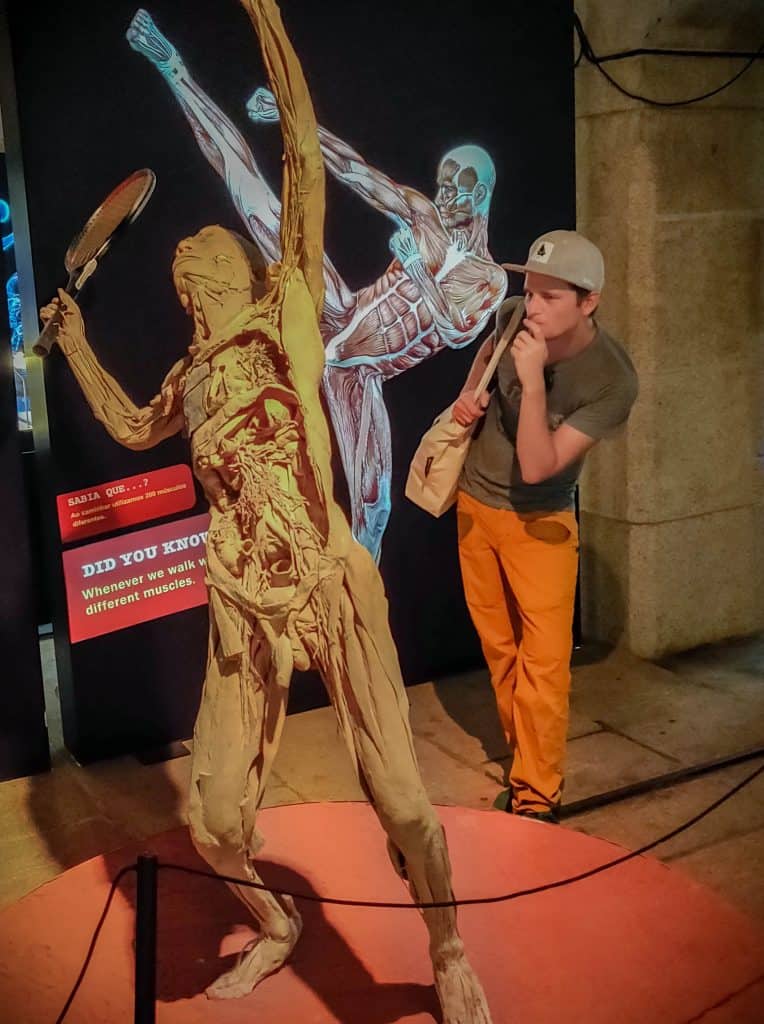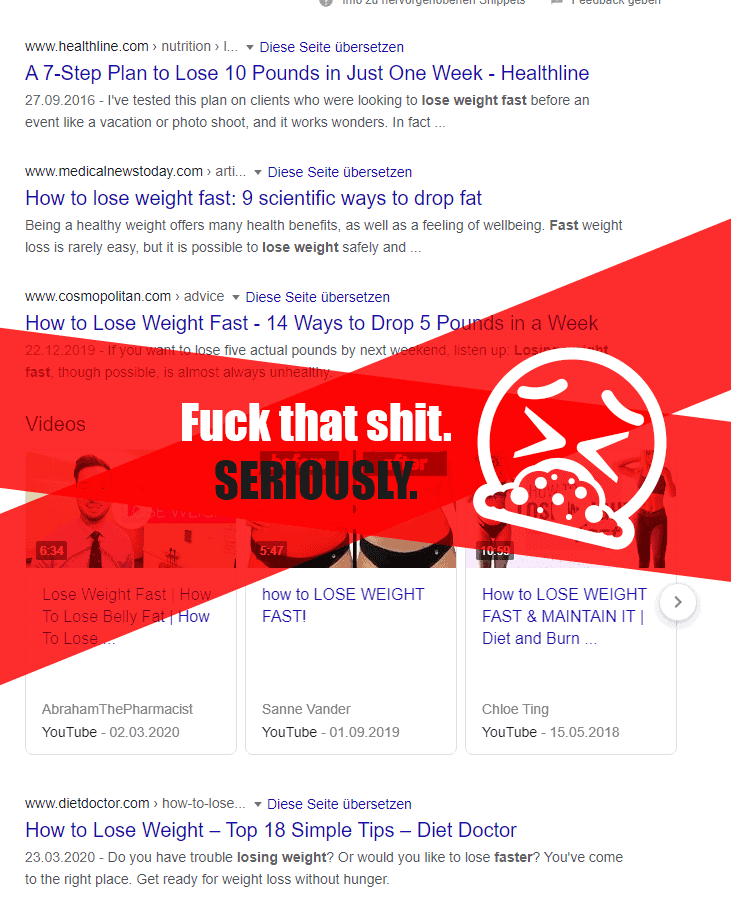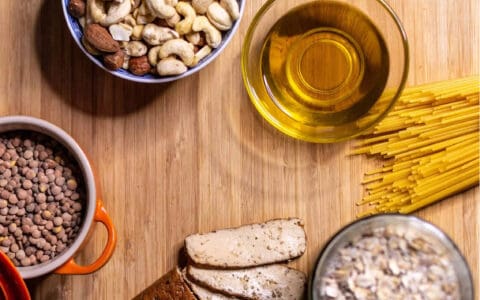Before going deeper into nutrients and their other areas of importance, I first want to focus on the main purpose of why we eat: to obtain enough energy. In this text, I will explain the basic mechanisms of how we use our food and the principles of our energy household and balance. You will learn how Energy, calories, and body weight relate to each other, in order to approach a change safely.
The information in this article may equip you with the tools to start counting your calories, but I do not recommend doing that at all. If you want to work on a healthy lifestyle, I tell you this is not the way. The goal is to understand the basic concepts of energy and how our body handles it.
Energy is what keeps us alive. Without energy, our internal processes would come to a halt, and we decompose to dead inorganic matter. Energy allows us to breathe, see, smell, hear, talk, walk, think and more.
The form of energy our body mainly uses is a small Molecule called ATP - Adenosine triphosphate. It gets produced by the so-called mitochondria, that lives within each cell of the body. ATP there gets recharged using the energy provided by carbs, protein, fat and alcohol.
ATP
ATP, or Adenosine triphosphate, is a molecule that can hold three phosphate atoms. It is your body's preferred form of storing and providing quickly accessible energy. When one unit of phosphate is removed from the molecule, energy gets released, and the molecule becomes a diphosphate, or later, monophosphate.
To recharge it to an energy-rich ATP molecule, carbs, fat, and protein energy gets extracted in the citric cycle, also known as the Krebs cycle. You can think of ATP as a very small energy currency that can be transported quickly and used on demand when and where energy is most needed. During the day, our body recycles more ATP than our entire body weights.
ATP is consumed in almost any process in our body. It is used to control neural signals, fire up chemical processes, and think, and physical activity. But most of its energy goes into body heat. Whenever energy is released, only parts of it can actively be used. Around 80% of the energy, however, radiates in the form of heat, known as thermogenesis. You can estimate that around 1kcal per kilogram of body weight gets used for heat production
How many calories are there in each macronutrient?
The energy we consume is not directly usable by our body. It first needs to be broken down to recharge ATP. The nutrients we can absorb energy from are carbs, protein, fat and alcohol. Each nutrient carries a specific amount of calories.
- Fat: 9 kcal /g
- Alcohol: 7 kcal /g
- Protein: 4 kcal /g
- Carbs: 4 kcal /g
When food arrives, energy first gets transported to where it is needed at the moment. The rest of the energy provided by our meal then gets stored. Before it lands in our body fat, our "fast" storage gets filled.
Both the liver and our muscles can store energy in the form of glucose (sugar). While the storage capacities of the liver and muscles are limited (the muscle capacity can be expanded, though), they are capable of a quick and controlled release of stored energy when needed. Extra calories exceeding these capacities get stored in your body fat. A storage distribution of energy can look like this in a person with 70 Kilos / 154 pounds of body weight.
| Type of energy in kcal | |||
|---|---|---|---|
| Storage | glucose (carbs) | fat | protein |
| Liver | 400 | 450 | 400 |
| Body fat | 0 | 135 000 | 0 |
| Muscles | 1200 | 350 | 24 000 |
The Basal metabolic rate and how energy gets used
We constantly need energy to function. Our body needs to keep its temperature, breathe, circulate blood, think, and grow its cells. The majority of energy we burn daily is usually not used to be active but to keep the engine running. The energy we expend as a baseline is called the basal or basic metabolic rate (BMR). There are many ways of estimating the base rate, both through complex formulas and simple estimates.
As rule of thumb you can follow this easy calculation:
- Bodyweight in KG x 22 for Women
- Bodyweight in KG x 24 for Men
Remember that this is an estimate, and your actual base metabolic rate can be further defined by genetics, age, muscle mass, and hormonal fluctuations.
If you rarely move during the day, the basal metabolism can easily mark 70% of your total calorie burn. A more active lifestyle or job allows you to burn more calories. Multiply your base rate with a factor between 1.2 and 2, depending on your activity level from low to high, you get a rough estimate for what your total calorie burn is. It is, however, an estimate and cannot replace a proper lab analysis.
Energy burning modes during sport and activity
Depending on your type of activity, the body swaps between several energy-burning modes. For quick, intense exercises like pull-ups or sprints, our body relies on stored ATP directly as an immediate energy source. This stored ATP is depleted in a matter of seconds, leading to a feeling of muscle fatigue.
You may notice this fatigue when performing pull-ups and feel your arms become less capable of pulling your weight. However, if you allow a short break, you can resume pull-ups as new ATP is transported into your muscles. Generally, your body reacts to local deficits of ATP. It releases ATP from other parts of your body and sends it to the area where needed. Your energy is back in only a few minutes, and you can repeat the exercise.
This type of fatigue can be distinguished from the symptoms of fatigue experienced after prolonged exercise. During longer workouts, other factors like the buildup of lactic acid come into play, leading to long-lasting soreness and a different sensation of fatigue.
For activities less intense and demanding, your body does not touch the ATP reserves. It fills the need by producing new ATP from either glucose or fat on the fly. Glucose, or carbs, can release energy around twice as fast as fats, while fats are more energy-dense and provide you fuel over longer periods.
Carbs are burnt when energy is needed fast (anaerobic), while on lower activity levels the body burns a combination of fats and carbs. Via training, it is possible to leverage each supply type's storing and access capabilities to a certain degree.
Depending on your intensity and duration of exercise, it can be more likely to burn carbs or fats. High-demanding exercise like intense cardio training requires high energy to be delivered quickly. Here, glucose fits the job best, as its energy gets released in no time.
If however, you expand energy more slowly or empty your glucose reserve, the body can switch on the fat-burning mode, making use of bigger energy reserves from body fat. It can make a big difference whether you expend 200 kcal from high-intensity training, or a slow but steady workout. High intensity tends to lean more towards the use of carbs, while a slow and low-intensity workout has more fat-burn potential.
Keep in mind, that at the end the caloric difference long term will be the major factor for weight change, not necessarily what type of calorie gets used first.
There are multiple working approaches leading to the same goals, be it cardio-focused workouts that burn more energy directly, resistance training that raises your Basal Metabolic rate, or a combination of both.
Working with energy, calories, and body weight
No matter the goal, a majority of people seem to be concerned about their body weight. While athletes try to hit their calorie goal not to lose valuable muscle, others might want to get rid of body fat to drop weight.

Even though it is possible to influence what type of energy source is preferably used in exercise, the actual calorie balance at the end of the day matters. You will build up body fat if you gain more energy than you burn during a period. If you keep burning more than you consume, your body weight decreases.
However, it is not that easy, since this rule also knows its limits. In the end, the body still runs on the genetic code of survival of our ancestors. Just because we had the industrial revolution and get fed easily, this does not mean we are not functioning like in the age when getting our nutrients was our main concern.
To be energy efficient meant a better chance to survive. Muscle that we don't use actively, therefore, consumes too much. If we don't move we will lose this tissue again to become more "economical" and efficient. Like this, the food we can find helps us to survive longer.
The same happens if you cut your calories too low. Your genetic survival instinct detects this bottleneck and will cut the calories burnt wherever possible. As a consequence, you lower your overall metabolism. Consequently, your initial reduction of the calories gets overtaken by your metabolism and pile up body fat on your hips again.
Energy and weight loss in a healthy manner
Your caloric intake should be lower than your calories burned to lose weight. Remember this as the basic rule. However, you also want to avoid triggering your survival instinct in order to save the energy again.
To stay safe, try not to undercut by more than 15% of your daily needs. Doing this can slow down your metabolism and sacrifice muscle instead of fat. Considering that one gram of fat has 9 calories, you should be aware that rapid weight loss is not possible without sacrificing muscle. 15% of 2000 calories make only 300 kcal. That's roughly a Croissant or a medium-sized Snickers. The good news is: that one Snickers can make a difference already.
Calculate your calories and weight change potential
Basal metabolic rate
daily calories burnt
Your calorie difference:
Your daily body fat change:
Your calorie intake should not lower than 15% of your daily energy need (you are at %)
When taking those 15% as a hard limit based on a daily energy need of 2000 kcal, your lower limit for calories should be around 1700 kcal. With the 300 calories saved you burn 33g of body fat daily. That's roughly one kilo of body fat per month or 230g per week.
Why so many diet programs are bad
Many diet plans promise rapid weight loss and play with temptation. 5 kilos in just two weeks? Oh yes - this sounds too good to be true. But does it sum up?
Even if you ate nothing at all - with 2000 kcal burned you would roughly lose 222g of body fat per day or 3.1 Kilos in 2 weeks. That's still 2 kilos below the promised result, despite not providing any food at all.
When encountering a super promising diet plan, you should be able to see through and find how big of a lie and danger this promise can be. Being sceptical is the most healthy thing you can do when checking your options.
Falling for one of these promises is even more dangerous. A massive cut of energy usually comes with a massive cut of other nutrients, which can lead to a variety of deficiencies and health-related problems.
Your diet makes you sick if you expose yourself to a deficit over a long time. It can drive acute symptoms and, when long-lasting, cause permanent damage through degenerative disease.

So what if you do a month of diet to reduce body weight? Sure, you might see good progress in the beginning. That is often explained by loss of water and the drop of previously high amounts of food in your guts.
After a couple of days, the speed of weight loss then usually slows down rapidly and follows the maths explained above. You most likely will also lower your metabolism and lose muscle. Once your metabolism is adapted to your calorie intake, you will encounter weight gain again. This is well known under the term yo-yo effect.
When not interpreted correctly, this might lead you to taking the diet even more seriously and you start the circle again. You start treating yourself more strictly in order to underbid your metabolism again. The vicious circle becomes tighter and tighter, while your supply of nutrients gets poorer and poorer.
What happens if your diet ends?
Okay… Let's assume you pull off a program and follow a diet and lose weight in a controlled and healthy manner. At some point you reach your goal. And now what?
If you happily reach your goal, you might want to return to "normal". This normal however is responsible for the body weight as it was before the diet. If you then continue as before, your body weight again will slowly climb up.
Making a diet as a "one shot" out of the sudden appears pretty pointless. All this self-torture on the long run only causes you harm and leaves you even more frustrated once you realize you are back on your way to where you came from.
Healthy weight loss therefore is something slow and permanent. It is a change in your overall lifestyle. It is not a "program", that you can run and become a different person, like when you obtain a certificate that allows you to bear this and that title. No it is not. If you want to archive something permanent, you need to change your habits permanently.
The proper way of dieting
I think you got it by now. To change weight, you need to change your habits. You should not fall for any high numbers being promised to you, and you should accept that change in body weight and stature is a slow process bound to a permanent change of habits. But how do you start it?
The proper way of getting started is knowing where you are right now. If you watch your body weight over a week while not undergoing any diet changes and your body weight stays stable, your average dietary intake most likely hits your body's current demand. You eat more than what you need, if your weight is slowly and steadily climbing. A slow decline on the other hand, indicates a caloric deficit.
If you want precise numbers, you can make a lab test. By measuring the carbon dioxide levels in your breath while looking at your physical stress, it is possible to precisely mark your metabolic rate in both rest and activity. For most of us, a calculation and an honest estimate of our activity levels are usually good enough.
Remember that you have 3 touch points on which you can change your caloric balance: your base metabolism, caloric intake, and extra exercise. To lose weight, you raise the bar of what you need or lower your intake below the current bar.
Focusing only on one of those pillars can feel extreme and require a lot of effort and self-control. Since we are counting calories on both sides of the balance, you can get the same overall effect by slightly shifting each one of these 3 factors.

Practically, this can mean to be just some more active than before, while changing parts of your diet. Ever fancied to try out that yoga class? Dreaming of learning to dance? Go for it now! It does make a difference. At the same time, make a little change in what you eat. Cross out that sweet treat, change your calorie packed dinner for something less processed and more nutritional.
If you manage to raise your base metabolism through a more healthy and active lifestyle, your calorie gap even rises from what you initially started with. Things then might slowly speed up for you. Just make sure to not open the gap too far, in order to not let the survival mechanism kick in again. Keep things balanced.
The right mindset can support long-lasting change in body weight
Starting a dietary change might appear frightening. You probably are concerned about the cuts you have to make, fear missing out on social occasions, and potentially can picture change as an everlasting self-punishment. All those things that you HAVE to do or change in order to achieve one single goal can easily end up in a severe state of frustration.
All those things you have to drop and sacrifice in order to become that better version of you feel like an unbeatable challenge and a loss. You might drop confidence even before you start the change, which makes the first steps even harder. Combined with the experience of previous approaches, this might lead you to not even getting started at all.
This all can be different if you start changing your perspective. Take that ideal version of yourself, who might be your ultimate goal to be like. If you constantly ask yourself what you HAVE to change and improve on in order to BECOME this way, you are constantly facing situations that tell you how wrong, weak and impersistent the current version of you is.
Instead, start BEING your better self.
Your better self has good habits so that you can have them, too. Start off with the right confidence by seeing the world through the eyes of what you aim for. Think the way, act the way, be the way. Experience right from the start how well your better self feels by living this good lifestyle. Don't change to become. Be to experience the change.
When you confidently live by your ideal, the change will happen as a side effect. Don't focus on the cut you make to move away from your old self. Focus on how being the better self brings you a good feeling. Feeling superior over your old self automatically leads to improvement.
The right mindset and atomic habits help introducing change
Being aligned with your worldview makes it easier to see areas of change. You can spot habits or foods that do not fit your desires. If you encounter something not aligned with your targets, you have identified a potential area of improvement.
See this as atomic habit building. While aiming for some significant change, we can introduce that change through many minor adjustments instead of changing the game's rules through a big bang.
And this is a good thing. Think about what you can do differently to get a better outcome long term. if it is about sweets, start looking for similar sweets, but with fewer calories and more whole foods based nutrients. Most products exist in healthy and junk food variants. And this is a good opportunity to change an atomic habit.
So if you find a better version of your treat, it's easy to change your purchase behaviour. Soon, your habit of going for one product has changed for another. And you successfully onboarded a long-lasting improvement.
If you continue finding small atomic habits that you can change, the overall outcome of your lifestyle can follow.
In the end it is not about counting calories
To live healthy, you should ultimately not start counting calories. This is the best recipe to be stressed even before the start. Living healthy means to sleep well, be active, drink enough and eat well. And the good news are, that all of these factors also impact your metabolism. Keep in mind that every person burns energy differently. There is no single formula to cover all.
It is not about cutting and restricting. It is about change. Swap this processed junk food and replace it with something fresh and nutritious. Start cooking. And if you can't, then learn. The internet is full of easy to follow recipes. When you eat healthy, then you can eat much of it as well.
For a healthy lifestyle, you must look at more than just nutrition. Sleep and exercise go hand in hand with it to produce your personal feel good vibe. If you unlock them together, you start blooming in no time.
In a nutshell
You need energy in order to survive. Our bodies run on the instinct of our ancestors and is configured to be as energy efficient as possible. Carbs and protein deliver 4, alcohol 7 and fat 9 kcal per gram.
Healthy weight change is a slow and steady process and you should not undercut your caloric needs by more than 15%. A balanced approach in weight loss is a combination of activity and diet change.
A long-lasting change in body can only be archived by a change of your habits. A diet or sport program as a one shot often fires back and can leave you where you started off after a while. In the end a healthy lifestyle is more than just counting calories, but an overall improvement of your habits.
